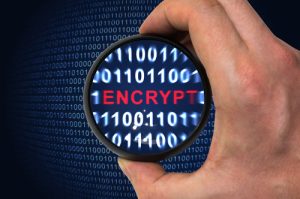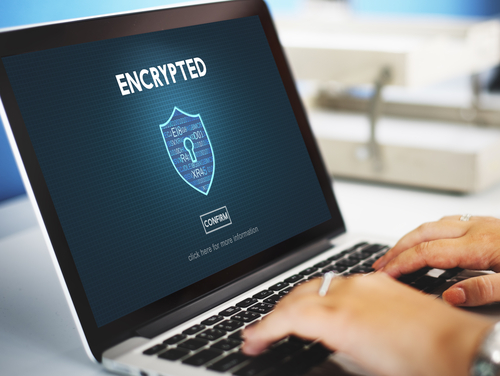If you have sensitive information you’d like to protect, you are probably looking at investing in encryption. AES encryption is one of the most state-of-art encryption algorithms to date. But, what is AES encryption. Advanced encryption standard, AES, is an encryption protocol that protects data as it is transferred online.
To learn more about this industry-standard cipher, read on.

What is Encryption?
Encryption is the process of taking sensitive information and converting it into an unreadable format. This is a form of cryptography where you are essentially using a secret code to convey information. However, the jumbled code is randomly generated using an algorithm.
This makes it impossible to decode unless you have the key. Much like a secret code, this key helps with the decryption process. There are different keys that encryption protocols can use. You can have asymmetric keys, or a combination of public and private keys, which are part of the public key infrastructure (PKI).
These use one key to lock the content into plaintext and another to unlock the ciphertext. Asymmetric encryption is a part of SSL/TLS encryption protocols. Encryption protocols can also use symmetrical keys for authentication, which are the same encryption keys used for both encryption and decryption.
With symmetric keys, you and the recipient both need to know the key, to be able to share information. Some types of encryption use both asymmetrical and symmetrical keys as part of their protocol. People use encryption to protect their emails and other digital correspondence top secret. There are several different encryption protocols, but AES is considered the industry standard.
What is AES Encryption?
Advanced Encryption Standard (AES) uses symmetric encryption. So, users need to have access to the same key to encrypt and decrypt the data. AES encrypts data before it is sent, so people cannot access the data during transit. Only those with the correct passkey can decrypt the message.
What makes AES unique is that instead of turning the entire message into ciphertext, it takes the message and breaks it into smaller blocks. These blocks are then encrypted in multiple rounds using substitution, transposition, and mixing to make the encryption more secure.
AES is so secure, the U.S. government uses it to protect sensitive data. Yet, it is also used by private and public entities to enhance their cybersecurity.
Why Was AES Encryption Developed?
In 1997, the National Institute of Standards and Technology (NIST) announced a public request for encryption protocols to replace the Data Encryption Standard (DES), which was the most commonly used protocol of the time.
DES was becoming less secure because it was subject to brute-force attacks, a hacking method used to crack codes by inputting keys over and over using trial and error until they gained access. The DES protocol had been adopted when computational power was far less sophisticated than it is today.
This public request resulted in several submissions from different countries, 15 of which were considered as a replacement for DES. Belgium cryptographers Joan Daemen and Vincent Rijmen’s new program Rijndael was accepted by the NIST.
This new standard was renamed AES. The new program took into consideration the growing use of hardware and software through the internet.
How Does AES Encryption Work?
AES encryption algorithm is a symmetric block cipher that uses a Substitution Permutation Network (SPN) for its encryption process. SPN is a series of linked math operations that use substitutions and permutations to build stronger block ciphers.
The way that AES encryption works is that it performs operations on bytes of data. Each block size is 128 bits, so the cipher processes 128 bits of input data at a time. This is broken down into 16 bytes of 4×4 matrixes.
The matrix is shifted using a key schedule that jumbles the characters in a pattern of rounds. AES uses key expansion which uses the initial key is used to create new keys called round keys. AES considers each block as a 128-bit grid. Each round has 4 steps to it.
The first step uses substitution or sub byte take each byte and substitute it with another. This step uses an S-box to substitute each byte. These bytes are never substituted alone nor are they substituted with complements.
Secondly, the protocol performs ShiftRows, which is where the rows of the matrix are shifted a number of times to mix up the data. The first row is not shifted. The second row is shifted once to the left, and the third row is shifted 3 times left. The fourth row is shifted 4 times left.
Next, the protocol performs a MixColumns. This multiplies the matrix, which changes the position of each byte. Finally, add round keys, which make the data appear as 128 bits of encrypted data rather than the matrices. The 4 steps are repeated for a number of rounds until the entire data set is encrypted.
When the decryption key is inputted, these steps are performed in reverse to decode the ciphertext.
Types of AES Encryption
AES algorithms use different key sizes. There are 3 lengths of AES encryption combinations. Each length produces a different number of possible key combinations. Even though the key length varies, the encryption block size remains at 128-bit blocks.
Here are the 3 AES encryption key lengths:
- 128-bit key length
- 192-bit key length
- 256-bit key length
The reason there are 3 different AES key lengths is because different devices have varying resources. Longer key lengths use up more resources. The main difference is in the number of rounds used to encrypt the data.
Here is the breakdown of rounds per key length type:
- AES-128 uses 10 rounds
- AES-192 uses 12 rounds
- AES-256 uses 14 rounds
AES-256 is considered military-grade encryption. However, AES-128 works well and may be more efficient for an app that wants to avoid draining a phone battery.
Is AES Encryption Secure?
Advanced Encryption Standard is considered one of the most secure types of encryption available. However, as technology continues to advance there is a likelihood that AES can still fall prey to cyberattacks. The attacks, however, are not a result of a failure in the algorithm itself, but of the implementation of AES on local devices.
Human Error
Since keys are secured using passwords, the greatest weakness is human folly. If you decide to implement AES encryption, you have to commit to making secure, frequently refreshed passwords. If you don’t want to go through the hassle of keeping up with these passwords, you may need to invest in a good password manager to help protect your keys from hackers.

Cyberattacks
There are two primary types of cyberattacks that show potential for breaking AES encryption. Side-channel attacks are when a hacker uses a data leak as a gateway to bypassing the encryption. That’s why it’s essential that people use AES correctly to prevent these attacks.
To keep AES up-to-date, cryptographers work to crack the encryption in order to test how strong it is. So far, AES has withstood the attacks. Yet, one attempt shows an area in which AES may be vulnerable. A related-key attack is when the hacker attacks the encryption key itself rather than trying with brute force.
In 2009, MIT successfully cracked an AES-128 encryption using a related-key attack. This test showed that the attack was successful against the 8-round version of the 128-bit key length. But, AES-128 uses 10 rounds of encryption, so the attack posed no danger in real life.
Again in 2011, crytographers worked to check AES for vulnerabilities. They discovered that the algorithm could be cracked, but this would take trillions of machines around 2 billion years to retrieve the key. Still, to secure the encryption further, 4 additonal rounds were added to the AES-128 encryption.
Yet, this slight success shows that in the future, someone may be able to attack AES. For the time being, however, this is the most successful and secure encryption protocol out there. AES encryption has no backdoor and is very effective at keeping out hackers.
As long as AES encryption is implemented properly, it is unbreakable.
Benefits of AES Encryption
If you are considering adopting AES encryption for your personal or business communications, there are several benefits of using AES encryption to consider.
#1 You Can Balance Usability and Security
Since AES encryption has 3 key lengths, developers can choose which length works best with their app or program. This versatility makes this high level of encryption more accessible to a variety of people and businesses. Instead of sacrificing speed and performance for security, companies can choose to balance these elements by choosing the best key length for them.
#2 Has a Variety of Uses
AES can encrypt data on hard drives, it can secure communications on messaging apps and through email, it can be part of a programming library, it can be a part of file compression programs, be applied to internet browsers, and protect government secrets.
AES can even be used to protect wireless devices like keyboards, earbuds, and mouses. Debit and credit cars with chips, wireless key FOBs for cars, and cryptocurrency also use this type of encryption to protect their services.
Since AES can be used in so many different facets, it has become a ubiquitous tool meant to increase cybersecurity for all users.
#3 Improves Data Protection
AES encryption is great for businesses and individuals alike. When you use AES for your small business, you enhance your data security. Many businesses transfer a lot of sensitive data on a daily basis, and AES encryption can help to protect the business from data leaks.
It can also keep the clients’ information safe from prying eyes. AES also gives your business a better sense of security, so that customers worried about the insecurities of the internet will feel safer with your products.
As an individual, you can share pictures, files, and messages with others while keeping that information safe. It offers you a more secure way to communicate with friends, family, and businesses without hackers gaining access to your personal identifiable information.
You can discuss legal documents or personal information securely using AES encryption properly. Since hackers cannot intercept your information, as long as you safeguard your keys, you will keep your communications out of the hands of people who might abuse that information.
Sekur’s Encryption
If you’e ready to enhance your privacy, consider Sekur. We have encrypted Swiss-Hosted email, VPN, and instant messaging that will keep your data private. We use a multi-layered 2048-bit encrypted tunnel with proprietary HeliX technology to make sure all your communications happen in our Swiss secure servers only.
With SekurMail you can send encrypted emails outside of Sekur and have your recipient reply within our Swiss secured environment. You can also monitor your email activity, send unlimited-sized attachnements, and migrate your existing email over to our server easily with our migration tool.
Sekur VPN keeps your IP address anonymous online. Our military-grade advanced encryption, high-speed servers, and unlimited data will help you to navigate securly. It is easy to set up, download, and tap, and all your devices are associated under one license.
To enjoy fully private instant chats, Sekur Messenger offer 100% end-to-end encryption that you can use with non-Sekur users. There is no data mining and your chats self destruct across all devices.
Regain your privacy. Try out Sekur today.
Conclusion
The best type of encryption to keep your sensitive data secure is AES-256. This military-grade encryption takes your data, breaks it into smaller blocks, and shuffles the data around so that it is impossible to crack. AES is the most secure encryption protocol to date and is not vulnerable to any attacks, to date, unless AES is not implemented correctly on the device.
It’s important to make sure to keep your passwords secure and up-to-date and to only share your passwords with people you trust. With this in mind, using Advanced Encryption Standard protocols for your private or business communications is a secure way to ensure your data is protected from hackers.

